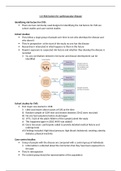Summary
Summary SNAB 1.3 Risk factors for cardiovascular disease
- Institution
- PEARSON (PEARSON)
I am currently an A level student and completed the AS exams last year. I know how difficult it is to revise from the textbook so I have made concise notes on the first 4 sub topics of topic 1, including relevant diagrams from the textbook. I will make more if I gain interest! Good luck :)
[Show more]




